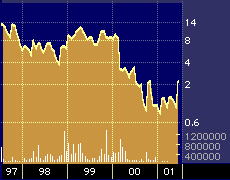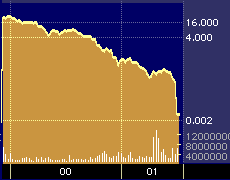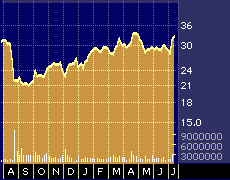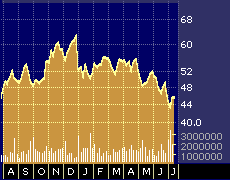
HomeGrocer IPO Makes Tepid Debut
HomeGrocer IPO Makes Tepid Debut
by Hal Plotkin
Silicon Valley Correspondent
If comparable offerings are any guide, investors who buy into HomeGrocer.com Inc.’s {HOMG} initial public offering may end up holding an empty bag, at least over the short term.
Kirkland, Wash.-based HomeGrocer.com, which is 28 percent owned by Amazon.com Inc. {AMZN}, is the latest online grocer to go public.
And the stock hasn’t budged much at its open Friday, debuting at 12 7/8. Late Thursday, HomeGrocer.com priced its 22 million share offering at 12 a share, at the top of its filing range of 10 to 12 a share.
Its rival, Peapod Inc. {PPOD}, based in Skokie, Ill., went public in June 1997 with shares initially priced at 16 a share. Last November, the industry’s self-proclaimed 800-pound gorilla, Foster City, Calif.-based Webvan Group Inc. {WBVN}, went public with shares priced at 15 each. Both stocks have disappointed investors who got in shortly after their IPOs.

PPOD: Post-IPO Performance Chart

WBVN: Post-IPO Performance Chart
“There are a lot of things the online grocers still have to work out,” says Rebecca Nidositko, an analyst with the Yankee Group, based in Boston. “They haven’t come up with a really profitable way to do this yet.”
Analysts say several factors are working against, or at least slowing down, firms hoping to revolutionize the way consumers in the United States shop for groceries.
Beyond the need to break down familiar grocery shopping habits, online grocers that make deliveries, such as HomeGrocer.com, Peapod and Webvan, Peapod, must also invest heavily in local, centralized distribution facilities, state-of-the-art inventory and order-picking systems, delivery trucks, drivers and constantly-evolving Web-site technologies.
“I’ll be optimistic about online grocers starting in about 2002,” says David Cooperstein, director of research for online retailing at Forrester Research, based in Cambridge, Mass. “There’s going to be a long, slow growth curve.”
Online grocers are expected to account for about 4 percent of overall grocery sales, or $36.6 billion, by 2004, according to an estimate by Forrester Research. At present, just three percent of online shoppers have purchased groceries over the Internet. In a more hopeful sign for the industry’s future, however, 13 percent of young online shoppers, ages 16 to 22, have already ordered groceries online, according to Forrester’s data.
“It’s really too early to tell who the winners will be,” says Rob Labatt, an analyst at Dataquest, based in San Jose, Calif. “In the end, though, this isn’t about delivering groceries. It’s about delivering the last-mile solution.”
Like other analysts, Labatt says the most-important strategic opportunity targeted by firms such as HomeGrocer.com, Peapod and Webvan are the creation of fast-response local delivery systems that can eventually bring a wide variety of products directly to consumers’ doorsteps.
“Amazon has to be thinking about what comes next,” Nidositko says. “Their investment shows that home delivery is going to be a big deal. This [HomeGrocer.com] will be an interesting one to watch.”
Listening to online-grocery executives talk, however, might convince at least the casual observer that the industry is in the middle of something of an identity crisis. While delivering groceries is the centerpiece of what these firms currently do, most online-grocery executives take pains to emphasize that their future doesn’t depend on the success of that business over the long haul.
“They call it Webvan, not Webgroceries,” says Clay Ryder, vice president and chief analyst at Zona Research, based in Redwood City, Calif. “The name says it all.”
Analysts say it is a wise strategy, perhaps the only one possible, for online grocers.
“Most neighborhood grocers live on a one-percent margin,” Ryder says. “Selling groceries online for the same price as the store and then delivering them for free is a negative-margin opportunity.”
In addition to diversifying their product lines, the online grocers also hope to drive up their margins by building centralized distribution facilities and ordering systems that minimize overhead costs, especially by comparison with offline employee-intensive brick-and-mortar grocery stores.
“It’s going to be the cost structure that determines the winners,” Ryder says.
In the meantime, however, investors in online-grocery stocks may need more patience than is typically required for other Internet stock plays. At least some analysts think that patience could eventually pay off, though, particularly for investors who scoop up the right online-grocery stocks at their current low price levels.
“As a heavy user, I’m still positive on them,” Ryder says. “We order 80 percent of our food from Webvan, and, with two kids at home, I like the fact I can do our shopping late on a Thursday night. Once people use the service, particularly busy people, I think they’ll like it. Market capitalization is not always the best barometer of good ideas and success.”
“It works quite well,” agrees Labatt, who has also used Webvan. “It was a very pleasant experience. They seem to have their act together.”
On the other hand, the analysts also warn that it is quite possible that major grocery chains, such as Albertson’s Inc. {ABS} or Safeway Inc. {SWY}, may eventually begin making more effective use of the Internet in their own operations.

ABS: 52-Week Performance Chart

SWY: 52-Week Performance Chart
“They might not get into delivery,” Labatt says. “That’s very expensive. But they might use the Internet to allow consumers to order what they want and then pick it up on their way home. That could turn out to be more convenient than waiting for a delivery van to show up.”
HomeGrocer.com lost $39.1 million on sales of $10.8 million for the eight months ended Oct. 2, as compared with a loss of $4.8 million on sales of $299,000 for the same period a year earlier. The company’s services are currently available in selected cities in Southern California, Oregon, and Washington state. The company plans to begin service in eight to 10 additional regions over the next 12 months. Customers can select delivery times with a 90-minute time window.
Peapod lost $28.5 million in 1999 on revenue of $73.1 million, as compared with a loss of $21.6 million on revenue of $69.3 million in 1998. The company ships dry goods anywhere in the United States and, like its major competitors, has plans to build centralized distribution centers in an undisclosed number of new markets, in addition to the eight regions it currently serves.
Webvan posted a loss of $144.6 million in 1999 on sales of $13.3 million, as compared with a loss of $12 million on zero revenue in the prior year. The company currently offers service in the San Francisco Bay Area and plans to enter 15 additional metropolitan markets by the end of 2001. Consumers can select delivery times with a 30-minute time window.


